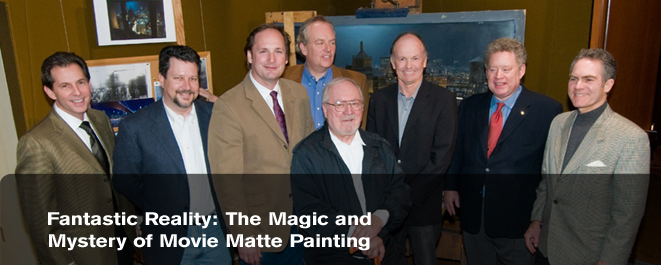|
Acclaimed
matte artists were finally given their due before a
standing room only house at the Linwood Dunn Theatre in
Hollywood, CA. In conjunction with this celebration
of an incredible art form, Craig Barron held a
showcase of matte artists called "Fantastic Reality:
The Magic and Mystery of Movie Matte Painting." The
cold December night didn't stop a lot fans from
showing up to get a possible ticket. The show was
sold out. It was held on December 12th,
2007.
Actors and directors receive a lot of kudos and
press for their work in the movies. Yet it's a crime
that some of the people who make them look great
aren't given much attention. This changed when
author (and visual effects artist) Craig Barron
co-authored the amazing book, "The Invisible Art"
(Chronicle Books). With Mark Cota Vaz, Barron did
extensive research on matte painters and their art
of illusion. And this winter, the Academy of Arts
and Sciences put on a matte show at the Linwood Dunn
called "Playing God: The Art and Artists of Matte
Painting."
For the "Fantastic Reality" show, the panel
discussion featured visual effects and matte artists
including John Knoll, Harrison Ellenshaw, Bill
Taylor, Chris Evans, and Matthew Yuricich.
The show featured digital slides of mattes dating
back to the early days of filmmaking, and digital
matte work of today featured in "Zodiac" (2007).
Alfred Hitchcock was one of the proponents of matte
painting. "The beauty of a matte shot is that you
can become God," he said.
The panel discussion was flavorful and entertaining.
Mr. Yuricich didn't mince words about some of the
people he worked in the past. The audience laughed
and seemed to enjoy what he said, even if it was a
little frank. Barron did a respectable job in
keeping the conversation going on. A photograph of
Harrison Ellenshaw as a child was shown. It's a
photo of he and Walt Disney. He told the story about
that picture, in which Walt pushed Harrison on
Disneyland's railroad on a cart. Harrison is proud
to say he was the first person on Disneyland's
railroad, but poor Walt was pretty winded after the
fact. Walt was also a fan of using mattes in his
studio's films and employed Harrison's father,
Peter, for many years. Harrison's own work has been
featured in "Star Wars" (1977), "The Black Hole"
(1979) and "Tron" (1982). His famous matte of the
Death Star reactor core scene in "Star Wars" was
shown on the Linwood Dunn screen and drew huge
applause.
Harrison's father, Peter, painted the one and only
matte shot in "Spartacus" (1960). This spectacular
matte opens up the "Rome" scene. The audience gasped
in awe when this was shown. The panel remarked that
Peter's work looks detailed on-screen, but when one
looks at it closely, it's amazingly simple (that's
what they think!-Editor). His matte was on display
in the lobby. People, including matte artist Chris
Evans, stood there looking at it for a long time in
admiration.
The attention to detail, lighting, perspective and
composition in matte paintings was readily apparent
in many of the slides shown that evening. It's truly
a valuable art form in and of itself, and can make a
movie come alive. It was nice to finally see a
spotlight shown on the likes of Norman Dawn, Walter
Percy "Pop" Day, Chris Evans, Craig Barron, Peter
and Harrison Ellenshaw, Alan Maley, Neil Krepela,
Michael Pangrazio, John Knoll and Matthew Yuricich.
|
|
(left
to right) Science and Technology Director Andy
Maltz, Oscar winning visual effects supervisor
and Photoshop co-creator John Knoll, moderator
and Oscar nominee Craig Barron, Chair of the
Science and Technology Council's Public Programs
and Education Subcommittee Tad Marburg, Oscar
nominee and matte legend Harrison Ellenshaw,
visual effects supervisor and Academy Governor
Bill Taylor, chief matte artist at Matte World
Digital and Oscar nominee Chris Evans, (seated)
and visual effects supervisor and Oscar nominee
Matthew Yuricich |



